Abstract
The radiated immunity of passenger cars and commercial vehicles is validated using electromagnetic interference from off-vehicle radiation sources in an anechoic chamber according to the procedure in ISO 11451-2. Common electrical or electronic vehicle systems, including dual flash, monitors, and entertainment systems, must be validated using a standardized immunity evaluation procedure. However, Automated Driver Assistance System (ADAS) functions often lack verification in complex electromagnetic fields, which might create potential risk due to electromagnetic compatibility problems. For example, radar and camera sensors based on autonomous emergency braking (AEB), adaptive cruise control (ACC), or lane departure warning (LDW) functions may be ineffective in the real world if subjected to electromagnetic interference. This paper presents a new methodology to evaluate vehicle immunity performance based on the main ADAS functions. A target simulator and a virtual driving environment are designed to trigger AEB, ACC, and LDW functions in an anechoic chamber. Moreover, the vehicle In-the-Loop (VHIL) conception is also applied by acquiring and analyzing key ADAS-related signals. The reliability of ADAS functions at the whole-vehicle level can be evaluated and improved using standardized external radiation sources.
1. Introduction
Due to the significant reduction in traffic accidents by emerging intelligent technology in the vehicle industry, vehicle manufacturers place a very high priority on the development of these intelligent systems [1,2,3]. Intelligent vehicles are typically equipped with a dense array of electric and control systems designed to provide the highest level of protection for vehicle occupants and vulnerable road users. Based on the Advanced Driver Assistance System (ADAS), the intelligent vehicle can handle multiple traffic scenarios such as AEB, ACC, and LDW. Different sensors, such as cameras or radar, collect environmental information on the vehicle [4]. Controllers and actuators with automated and electrified characteristics can ensure that the vehicle adopts the correct behavioral response as quickly as possible to prevent traffic accidents [5,6,7]. The accurate and timely operation of ADAS functions is closely related to optimized algorithms and reliable electronics [8,9,10].
Therefore, the reliability of ADAS systems must be verified in various environmental conditions. Due to sensitivity of electronic systems to electromagnetic interference, the immunity of the ADAS system to the electromagnetic environment is very significant in the real world [11,12,13]. Common radiation sources include transmission lines or stations, radar stations, broadcast base stations, GSM/LTE base stations, GPS, etc. [14]. These electromagnetic fields pose potential threats to the dependability of ADAS electronic devices. Therefore, it is necessary to verify the radiation immunity of ADAS function in intelligent vehicles. A growing number of technical reports focus on test methods for ADAS functionality in vehicle radiation immunity [11,14]. These are based on traditional setups in ISO 11451-2 as shown in Figure 1 [15]. The research presented in [9,16,17] focuses on the use of radar simulators for ACC immunity testing. However, this study only demonstrated the activation of ACC in an anechoic chamber and performed no actual radio immunity testing. Currently, there is no evidence that any radar simulators available on the market can satisfactorily simulate high levels of radiation fields, which typically require up to 200 V/m. Radar simulators are usually used to develop radar components rather than for vehicle testing. Another study introduced the concept of EMS (electromagnetic susceptibility) testing for intelligent vehicles [14], but it lacks actual testing experience. Although [9,18] provide some information regarding test methodology, an actual test must consider the following: a customized virtual driving environment, an automated test software framework, the acquisition of key data, etc.
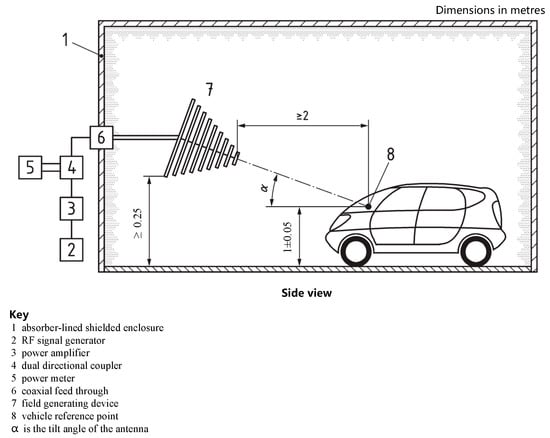
Figure 1.
Typical setup of the whole-vehicle radiated immunity test according to ISO 11451-2.
Radiated immunity tests of ADAS functions in an anechoic chamber must overcome three major challenges as described in prior work [19]. First, more complex radiated sources must be considered. Second, ADAS functions such as ACC, AEB, or LDW must be activated in an anechoic chamber. Third, it is essential to evaluate key ADAS-related signals using vehicle sensors. In this study, the above problems were addressed; the whole vehicle in the ring experiment scene was built and the whole vehicle in the ring verification was successfully carried out. This study provides a feasible test scheme for the electronic safety detection of intelligent vehicles, reduces the electromagnetic compatibility risk of intelligent vehicle ADAS, and ensures the travel safety of drivers and passengers. It is of great significance to the sustainable development of intelligent vehicles.
This work mainly introduces the principle of an up-to-date ADAS immunity performance test platform based on the VHIL concept. The subsequent section will introduce the test platform that considers both radar-based and camera-based activation of ADAS functions. The factors that influence field distribution are discussed in the third section. The fourth section demonstrates the software platform to automatically combine the virtual road environment, data acquisition or analysis, and EMS test process automatically. The next section will present a real example of a radiated immunity test. The conclusion will be presented in the final section.
2. VHIL-Based Radiated Immunity Test Platform
The proposed radiated immunity test platform utilizes the VHIL concept, which is often used to evaluate the performance of platooning experiments. Figure 2 shows the VHIL-based test setup used to validate ADAS radiation immunity in an anechoic chamber. Typical radiated sources were used, including a signal generator, a high-power amplifier, and an immunity antenna to simulate an electromagnetic environment. The Vehicle Under Test (VUT) was mounted on a dynamometer that simulates a road. Here, a millimeter wave radar simulator with a 76–81 GHz band was used to simulate an artificial target, and the simulator moving on a rail was used to simulate a mobile target. Considering the complex electromagnetic environment, all the signal channels need to adopt an optical-fiber system given the high-strength electromagnetic field. Using a controlled sliding rail, target transverse velocity can be simulated.
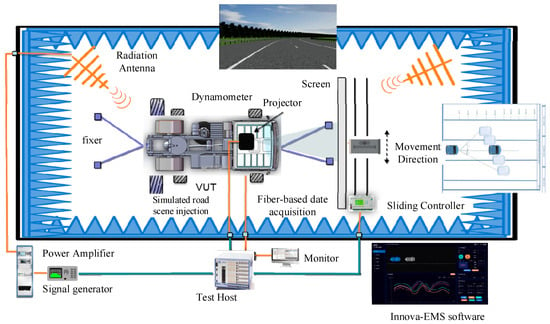
Figure 2.
Developed test platform Innova-EMS to evaluate the radiation immunity of the vehicle from external radiation sources considering VHIL.
The projected screen displays the road environment to trigger the LDW function based on the vehicle camera. Moreover, in the immunity test, the vehicle is operated using a brake and throttle robot. The status of vehicle ADAS functions can be observed through the monitor system. All relevant ADAS signals, including audio, vibration, velocity, and bus data, can be transmitted in real time to a host equipped with the software platform.
In the real radiated immunity test, the developed Innova-EMS platform can apply the customized virtue target vehicle and road environment conveniently. This design with specific velocity and distance can be simulated by a radar simulator based on the Doppler effect and time-delay algorithm [16,17]. In addition, the image can be projected on the screen, which can be managed by the algorithm for the vehicle camera.
2.1. Radar-Based ADAS Functions Activation in an Anechoic Chamber
Concerning the activation of ADAS functions in an anechoic chamber, the ACC function is the most difficult to realize. Currently, the updated radar simulator can realize the moving target at a distance of up to 250 m, and a maximal speed of 300 km/h speed (see Figure 3). To assess the radar-based ADAS functions for the entire vehicle, the antenna reflection problem on the radar simulator must be resolved. We designed a special absorber material for the radar simulator, as shown in Figure 3, to prevent electromagnetic wave reflection and high-level radiated fields in immunity tests. The other challenge is to simulate lane changes by the target vehicle. The proposed solution was to mount the radar simulator on a sliding rail with the same transverse velocity as the target. Other radar-based functions, such as AEB and FCW, are very similar to the activation of ACC, but their trigger parameters differ.
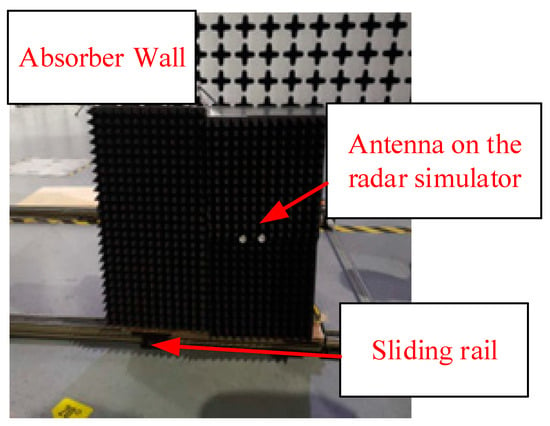
Figure 3.
ACC function test in an anechoic chamber using a radar simulator on rail.
2.2. Camera-Based ADAS Activation in an Anechoic Chamber
The key to LDW lane recognition is to calculate the geometric information of the lane lines on the road from the two-dimensional image information acquired by the camera sensor, which enables the reconstruction and identification of the lane lines [20,21,22]. To extract three-dimensional spatial information from two-dimensional images, a camera imaging geometric model must be established. If a virtual physical image is used in place of the actual object, the camera sensor is able to obtain the same image data for the object as when the actual object is used.
Therefore, a dynamic image, including lane lines of the road, can be used instead of the real road to activate the LDW function in an anechoic chamber. In this work, a shielding projector and a curtain were utilized to simulate a vision of road lane lines. The projector displayed a video on the vehicle camera sensor’s front curtain. This video was generated using Prescan [23], which captures dynamic images from a camera installed in the same position as a moving vehicle. The principle is shown in Figure 4. A small hole imaging model is adopted to simplify the imaging model of the projector and camera, and the trapezoidal correction function of the projector can correct the trapezoidal distortion. Consequently, we can establish the linear relationship:
Xb/Zb = u/f = Xp/Zp
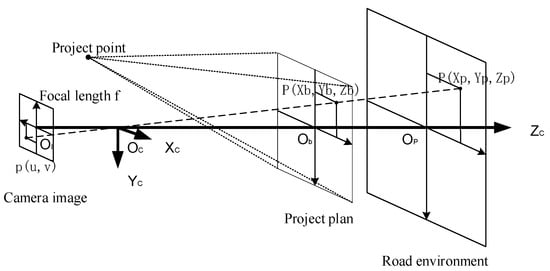
Figure 4.
Design principle of virtual road simulation.
As shown in Figure 5, the road width is represented by W, the distance from the camera is represented by D, the road width at the position on the projection screen is represented by Wx, and the distance from the camera is represented by Dx. Therefore, we can arrive at the following equation:
W/D = Wx/Dx

Figure 5.
Design principle of virtual road simulation.
For different vehicles, due to the camera positions, the different projecting images must be adjusted. The adjustment process is shown in Figure 6. As long as the road width in the projected image satisfies the requirements of Equation (2), the installation height and angle of the projector can be adjusted appropriately to satisfy the vision emulation requirement. For instance, the virtual road width W = 3.5 m at a distance D = 14.73 m from the virtue camera designed by the Prescan software. According to Equation (2), the road width projected on the screen is calculated as Wx ≈ 0.37 m when the real camera distance to the screen is Dx = 1.5 m. This is shown in Figure 7.
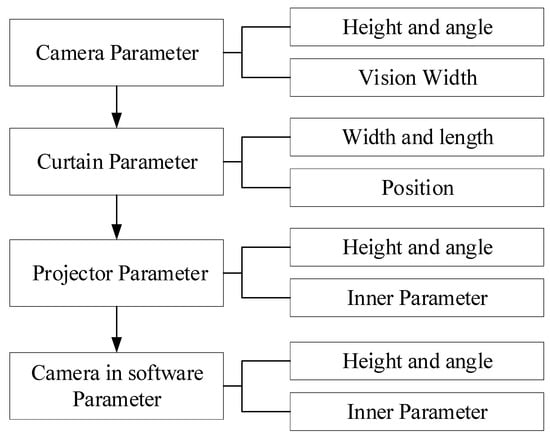
Figure 6.
Projector adjustment process.
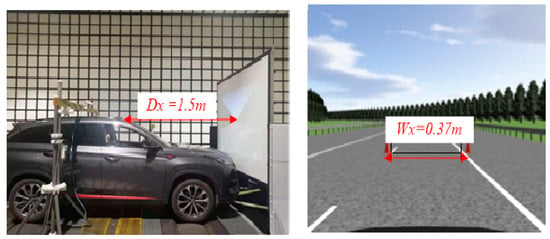
Figure 7.
Adjustment for activating the LDW function, distance from the camera to screen (left), and calibrated road width on the screen (right).
After the adjustment process, different virtual road environments can be realistic enough to activate the LDW. This paper used the vehicle simulation software Prescan to create a virtual road environment. The virtual camera was built into the software according to the parameters of the camera sensor for the LDW installed on the real vehicle. This video file was then projected onto the screen using a shielding projector to simulate actual road conditions.
Moreover, the FCW function is in some cases only based on the camera sensor. Figure 8 shows the successful activation of LDW and FCW functions in an anechoic chamber. The camera-based LKA (Lane Keeping Assistance) function [24,25], which also aims to keep the vehicle within the lane lines, can also be automatically activated in the anechoic chamber. In contrast to LDW, which has only a warning function, LKA includes a steering function, which is not possible on a conventional dynamometer. The solution to this issue will be discussed in a following paper.
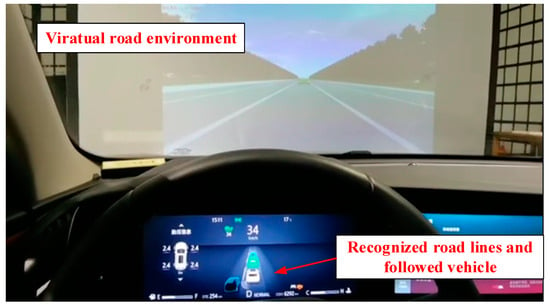
Figure 8.
Camera-based LDW and FCW function activation in VUT.
3. Factors That Influence Illuminated Radiated Field in an Anechoic Chamber
According to ISO 11451-2 [15], the radiated field emitted by the antenna must be calibrated by the observed points so that the input power from the power amplifier can be used to achieve the desired fields in the anechoic chamber. In the ADAS EMS test, the configuration of the absorber walls, the absorber box for radar simulator, and the stand for a screen around the VUT might distort the fields without the surroundings [26]. Therefore, it is necessary to investigate the effect of configuration surroundings on radiated fields.
As shown in Figure 9, this work modeled the absorber walls with relative conductivity εr = 10, relativity permeability μr = 1.6 with attenuation α = −30 dB, stand for the screen made of wood, and an antenna or VUT with perfect conduct. A radiated source with power P = 75 W was set as a uniform plane wave on the front of the VUT. As shown in Figure 10 (top panel), the fields at the camera point on the VUT vary from 80 MHz to 2 GHz. The electric field increased by approximately 5 dB from 80 MHz to 300 MHz, but it decreased by 5 dB to 8 dB from 1 GHz to 2 GHz as a result of the ADAS test configuration environment influence. Figure 10 (bottom panels) depicts the surface current at 300 MHz on the VUT. The apparent resonances on the VUT surface distribution are distinct between the two configurations. The reason for the field changes is the electromagnetic material in the test configuration, especially the absorber walls, which can distort field distribution uniformity.

Figure 9.
Simulation model of ADAS test configuration in CST.
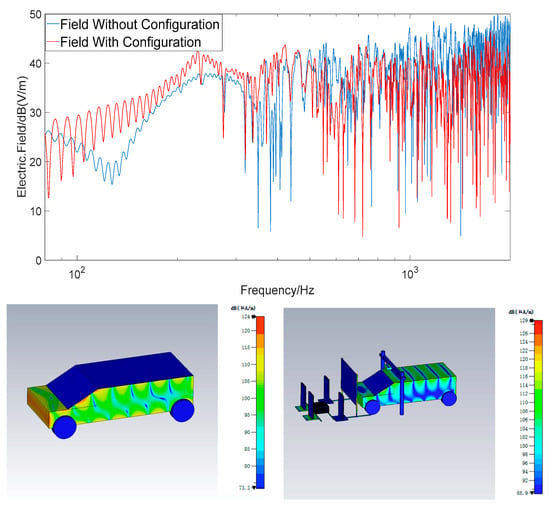
Figure 10.
Electrical fields at camera point on the VUT (top) and surface current distribution on the VUT at 300 MHz without and with absorber walls (bottom).
4. Test Software Development
The software was also developed to conveniently accomplish the radiated immunity test as shown in Figure 11. This software platform consists of four parts:
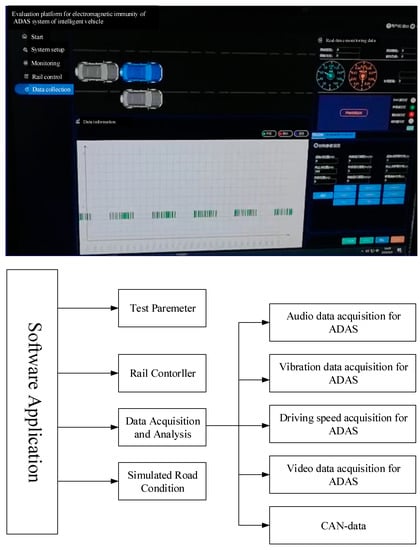
Figure 11.
Test software platform and the function frame.
- Part of the Rail Controller can control the rail remotely to implement the complex radar simulator;
- Part of Data Acquisition and Analysis can record and display vehicle status data (vehicle speed, acceleration, relative distance, audible alarm, vibration alarm, vehicle instrument alarm, vehicle bus information, etc.);
- Part of Simulated Road Condition can dynamically display the target vehicle and the vehicle under test.
5. Radiated Immunity Test Considering Vehicle In-the-Loop
In the developed test platform, the radiated immunity of ADAS functions needs to be evaluated. Usually, subjective and objective evaluation methods dominate EMS tests. Subjective evaluation entails observing malfunctioning phenomena, such as noise or distorted display from the monitor, during EMS testing of the VUT in highly radiated fields. Objective evaluation entails analyzing the error frame present in ECU bus data. Table 1 presents the main ADAS-related signals and evaluation criteria parameters for ADAS functions.

Table 1.
Main Signal Classifications and criteria.
This study used a whole-vehicle anechoic chamber to evaluate an intelligent vehicle with common ADAS functions. A 75 V/m radiated field was generated by a high-power amplifier and signal generator from 200 MHz–1 GHz. The test setup is shown in Figure 12 (left).
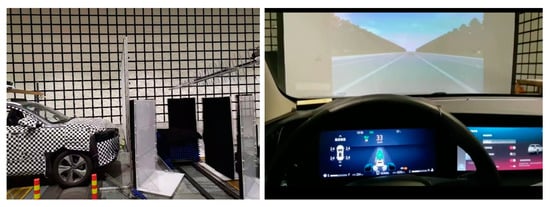
Figure 12.
Arrangement of radiated immunity for ADAS functions in an anechoic chamber (left) and the ACC function activation in the vehicle (right).
As shown in Figure 12 (right), the ACC function of the VUT was successfully activated in the anechoic chamber. Here, the VUT maintains a constant speed of 33 km/h at the cruise station. The virtue target vehicle is simulated by a radar simulator to trigger the ACC function. In this scenario, the target vehicle’s velocity changes, allowing the brake light to be observed by the EMC camera system, which is a common malfunction that occurs during the radiated immunity testing procedure. To trigger the LDW function, a virtual road lane scenario, based on ISO-17387, is projected on the screen mounted on the front of the VUT [14]. Judgment of LDW functions is based on the warning signals such as LED-light twinkle or seat vibration. However, this warning system relies heavily on an electronic system that is susceptible to EMS.
6. Conclusions
This paper proposed and developed a test platform for the radiated immunity of intelligent vehicles referencing the VHIL concept as shown in Figure 2. The developed software, as depicted in Figure 11, can easily implement the radiated immunity test in order to evaluate key ADAS functions such as radar-based ACC, AEB, or FCW functions and camera-based LDW or FCW functions. A radar simulator was used to simulate the target vehicle with different radar reflection efficiencies. A virtual road scenario was projected onto a screen in order to activate camera-based ADAS functions, such as LDW and FCW. ADAS functions were evaluated by recording the status of the dynamometer system or EMC camera in the presence of strong radiated fields. Due to the VHIL frame and software platform, all related key signals were captured and analyzed in real time for malfunction analysis when the VUT was exposed to a strong radiated field.
Using the test platform built in this paper, as shown in Figure 12, it is completely feasible to test the intelligent vehicle system for the stable operation of the basic functions of the ADAS system in an anechoic room environment. Video streams and radar reflected waves were used to simulate the driving environment around the vehicle. Scene calibration and false targets are important for stability testing, and, as shown in Figure 2 and Figure 5, the use of guide rails, absorbing materials, and scene scale calibration can stably adapt to the test of different vehicle models.
As shown in Figure 10, because a large number of absorbing baffles are used in the test scheme to eliminate the influence of the surrounding environment on the target detected by the vehicle radar, the simulation construction of the electromagnetic environment changes compared with the ordinary electromagnetic compatibility test. According to this simulation analysis results, it is necessary to compensate by increasing the radiation power and other methods in the actual test to achieve the standard radiation level.
Certainly, this work must be expanded for the validation of radiated immunity performance in additional scenarios. How to deal with the LKA function is still a challenge with the traditional dynamometer. ADAS-ECU bus data must be analyzed more deeply in the high-strength radiated field. Sensor fusion with radar, camera, or additional Lidar must be considered next. A more customized and sophisticated test scenario will be attractive in a real validation test.
Author Contributions
Conceptualization, Y.Q.; writing, review and editing, A.T.; methodology and formal analysis, J.J.; software, L.W.; validation, H.Z. and Y.L.; All authors have read and agreed to the published version of the manuscript.
Funding
This research was funded by the National Natural Science Foundation of China (Grant No. 52277213), Natural Science Foundation of Chongqing, China (Grant No. cstc2021jcyj-msxmX0464), Key project of science and technology research program of Chongqing Education Commission of China (Grant No. KJZD-K202201103) and Scientific Research Foundation of Chongqing University of Technology (No. 2021ZDZ004).
Data Availability Statement
Not applicable.
Acknowledgments
Thanks to China Merchants Car Research Institute for providing experimental equipment and experimental site support for this study.
Conflicts of Interest
Yanming Qin is an employee of China Merchants Testing Vehicle Technology Research Institute Co., Ltd. Heming Zhao and Yun Long are employees of Chongqing TSARI-CQUT Institute of Intelligent Technology Research Institute Co., Ltd. The paper reflects the views of the scientists and not the company. We confirm that there is no conflict of interest between the China Merchants Testing Vehicle Technology Research Institute Co., Ltd. and Chongqing TSARI-CQUT Institute of Intelligent Technology Research Institute Co., Ltd.
References
- Tang, H.; Wang, L.; Li, Z. Application Research on Driving Simulator for Automatic Driving System. Automot. Dig. 2020, 1, 28–31. [Google Scholar]
- Wang, Y.; Sun, W.; Lu, Y. Research on Application in Intelligent Vehicle Automatic Control System. J. Phys. Conf. Ser. 2021, 1828, 012046. [Google Scholar] [CrossRef]
- Tian, G. Research on the application of artificial intelligence technology in the field of unmanned intelligent vehicle. Jiangsu Sci. Technol. Inf. 2017, 14, 56–57. [Google Scholar]
- Martinez, C.M.; Heucke, M.; Wang, F.-Y.; Gao, B.; Cao, D. Driving Style Recognition for Intelligent Vehicle Control and Advanced Driver Assistance: A Survey. IEEE Trans. Intell. Transp. Syst. 2018, 19, 666–676. [Google Scholar] [CrossRef]
- Zhang, N.; Bao, X.; He, Y.; Lu, X.-H. Research on Path Planning and Tracking Method of Auto-driving Vehicles Under Complex Constraints. In Proceedings of the 2019 2nd China Symposium on Cognitive Computing and Hybrid Intelligence (CCHI), Xi’an, China, 21–22 September 2019. [Google Scholar]
- Huang, K.; Jiang, C.; Qiu, M.-M.; Wu, D.; Zhang, B.-Z. Research on intelligent vehicle lane changing and obstacle avoidance control based on road adhesion coefficient. J. Vib. Control 2021, 28, 107754632110291. [Google Scholar] [CrossRef]
- Ye, Q.; Wang, R.; Zhang, C.; Cai, Y. Research on Intelligent Vehicle Path Tracking with Subsystems Based on Multimodel Intelligent Hierarchical Control Theory. Math. Probl. Eng. 2021, 2021, 7448517. [Google Scholar] [CrossRef]
- Feng, J.; Song, W.; Zhan, H.; Bai, J. Research on Testing System for an Intelligent and Connected Vehicle. J. Phys. Conf. Ser. 2020, 1576, 012047. [Google Scholar] [CrossRef]
- Sun, T.; Ding, Q.; Li, W.; Li, J.; Anhui Province Key Laboratory of Intelligent Connected Technology; Anhui Jianghuai Automobile Group Co., Ltd. Design and implementation of ADAS system test platform. China Meas. Test 2019, 45, 151–156. [Google Scholar]
- Zhi, P.; Zhao, R.; Zhou, H.; Zhou, Y.; Ling, N.; Zhou, Q. Analysis on the Development Status of Intelligent and Connected Vehicle Test Site. Intell. Converg. Netw. 2021, 2, 320–333. [Google Scholar] [CrossRef]
- Han, Q.; Lei, J.; Zeng, L.; Tang, Y.; Liu, J.; Chen, L. EMC Test for Connected Vehicles and Communication Terminals. In Proceedings of the 2018 IEEE Intelligent Vehicles Symposium (IV), Changshu, China, 26–30 June 2018. [Google Scholar] [CrossRef]
- Liu, B.; Wang, J.; Wei, L.I. EMC standard for on-vehicle electronic components and modules. Telecommun. Netw. Technol. 2017, 6, 25–28. [Google Scholar]
- Kozan, M.D.; Uysal, M.M.; Usta, E. EMC test requirements for combat vehicles. In Proceedings of the 2017 IV International Electromagnetic Compatibility Conference (EMC Turkiye), Ankara, Turkey, 24–27 September 2017. [Google Scholar]
- Li, P.; Zhang, B.; Yang, L. An electromagnetic compatibility(EMC)test for a hybrid city bus. Automob. Appl. Technol. 2018, 5, 13–15. [Google Scholar]
- ISO Standard 11451-2; 4th ed. Road Vehicles—Vehicles Test Methods for Electrical Disturbances from Narrowband Radiated Electromagnetic—Part 2: Off-vehicle Radiation Sources. ISO: Geneva, Switzerland, 2015.
- Li, X.; Tao, X.; Zhu, B.; Deng, W. Research on a Simulation Method of the Millimeter Wave Radar Virtual Test Environment for Intelligent Driving. Sensors 2020, 20, 1929. [Google Scholar] [CrossRef] [PubMed]
- Jha, U.S. The millimeter Wave (mmW) radar characterization, testing, verification challenges and opportunities. In Proceedings of the 2018 IEEE AUTOTESTCON, National Harbor, MD, USA, 17–20 September 2018; pp. 1–5. [Google Scholar] [CrossRef]
- Gang, L.; Zhang, X.; Xu, S. Research on Electromagnetic Immunity Test Method of ADAS in Intelligent Vehicle. Safty EMC 2017, 3, 34–37. [Google Scholar]
- Jia, J.; Li, B.; Li, X. Research on the Radiated Immunity Test Methods of ADAS Functions in Intelligent Vehicles. SAE Technical Paper, 7 August 2018. [Google Scholar] [CrossRef]
- Bai, Y.; Jia, J.; Li, B. Vision Emulation Methods for Intelligent Vehicle Radiated Immunity Test in Anechoic Chamber. Int. J. Syst. Syst. Eng. 2020, 10, 195–205. [Google Scholar] [CrossRef]
- Holmes, D.; Gabler, H.; Sherony, R. Estimating Benefits of LDW Systems Applied to Cross-Centerline Crashes. SAE Technical Paper, 3 April 2018. [Google Scholar] [CrossRef]
- Mare, G.D.; Vico, F.; Crisci, F.; Montieri, A.; Amoroso, D.; Marino, B.; Ferrara, F.; D’Avino, C. An innovative real-time test setup for ADAS’s based on vehicle cameras. Transp. Res. Part F Traffic Psychol. Behav. 2018, 61, 252–258. [Google Scholar] [CrossRef]
- Hao Li, Precan HIL Steups for ADAS Applications, TASS International technical presentation, Mar., 2014.
- Yoo, J.H.; Lee, S.-W.; Park, S.-K.; Kim, D.H. A Robust Lane Detection Method Based on Vanishing Point Estimation Using the Relevance of Line Segments. IEEE Trans. Intell. Transp. Syst. 2017, 18, 3254–3266. [Google Scholar] [CrossRef]
- Song, H.; Zhao, F.; Hao, H.; Liu, Z. A Research Review on Vehicle Lane Changing Models Considering Intelligent Connected Vehicle and Distracted Driving Behaviours. In Proceedings of the 2020 China Society of Automotive Engineers Annual Conference, Qingdao, China, 8–9 August 2020. [Google Scholar]
- Ren, Y.; Wang, F.; Li, K.; Gao, B.; He, C. Analysis the Relationship between Opposites and Uniformity of Electromagnetic Field and Wave. J. Electr. Electron. Educ. 2019, 41, 84–87+109. [Google Scholar]
Publisher’s Note: MDPI stays neutral with regard to jurisdictional claims in published maps and institutional affiliations. |
© 2022 by the authors. Licensee MDPI, Basel, Switzerland. This article is an open access article distributed under the terms and conditions of the Creative Commons Attribution (CC BY) license (https://creativecommons.org/licenses/by/4.0/).